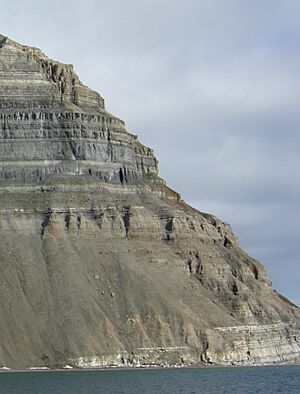Law of superposition facts for kids
The Law of Superposition is a super important rule in geology. It helps scientists understand the age of rocks and fossils. Imagine a stack of pancakes: the first one you made is at the bottom. The last one is on top! That's how rock layers work.
This law says that in layers of rock that haven't been moved, the oldest layers are always at the bottom. The newest layers are found right on top.
How Rock Layers Form
When tiny bits of sand, mud, or rock settle, they form layers. This often happens in places like oceans, lakes, or rivers. Over a very long time, these soft layers get hard. They turn into solid rock.
Each new layer forms on top of the older ones. This creates a natural timeline of Earth's past. The Law of Superposition helps us read this timeline. It tells us the order of events that happened millions of years ago.
For example, if you see a tall cliff with many rock layers, the bottom layer could be super old. The top layer would be much younger. This helps geologists figure out when different things happened on our planet.
Why This Law is Important
The Law of Superposition is a key tool for scientists. It helps them solve many puzzles about Earth's history.
- Dating Rocks and Fossils: This law helps scientists do "relative dating." This means they can tell which rocks or fossils are older or younger than others. They don't need to know the exact age in years.
- Understanding Earth's Past: By studying rock layers, scientists learn about ancient environments. They can find clues about old oceans, deserts, or even big climate changes. This helps us understand how Earth has changed over millions of years.
- Solving Geological Puzzles: Sometimes, rock layers get messed up. Things like earthquakes or volcanoes can bend or break them. The Law of Superposition helps geologists figure out what happened. They can put the pieces of the puzzle back together.
Cool Facts About Superposition
- A Danish scientist named Nicolas Steno first talked about this law. He did this way back in the 1600s! Many people call him the "father of modern geology."
- Sometimes, layers of rock are missing. This can happen because of erosion or other powerful forces. These missing parts are called "unconformities." They tell scientists about times when Earth's surface changed a lot.
- Fossils found in rock layers can help scientists match layers from different parts of the world. This cool idea is called the Principle of faunal succession.
See also
- Harris matrix
- Principle of cross-cutting relationships
- Principle of faunal succession
- Principle of lateral continuity
- Principle of original horizontality
- Stratification (archeology)
- Stratigraphy
- Structural geology


